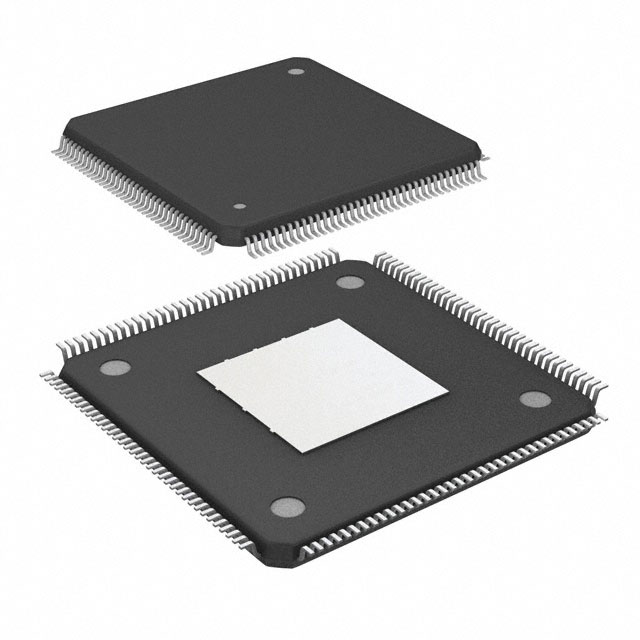Viz Specifikace pro podrobnosti o produktu.

EP4CE10E22C9L
Product Overview
- Category: Programmable Logic Device (PLD)
- Use: EP4CE10E22C9L is a PLD used for digital logic design and implementation.
- Characteristics:
- High-performance device with low power consumption
- Offers high-speed data processing capabilities
- Provides flexibility in designing complex digital systems
- Package: The EP4CE10E22C9L comes in a compact LQFP package.
- Essence: EP4CE10E22C9L is an essential component for building digital circuits and systems.
- Packaging/Quantity: Typically, the EP4CE10E22C9L is sold in reels containing multiple units.
Specifications
- Logic Elements: 10,080
- Embedded Memory: 414 Kbits
- Maximum User I/O Pins: 179
- Operating Voltage: 1.2V
- Speed Grade: C9
- Package Type: LQFP
- Temperature Range: Commercial (0°C to 85°C)
Detailed Pin Configuration
The EP4CE10E22C9L has a total of 179 user I/O pins, which are programmable and can be configured based on the specific requirements of the digital system being designed. These pins provide connectivity to external devices and components, enabling data input/output operations.
For a detailed pin configuration diagram, please refer to the official documentation provided by the manufacturer.
Functional Features
- High-performance FPGA with advanced architecture
- Flexible and reconfigurable design options
- Support for various communication protocols
- On-chip memory resources for efficient data storage
- Built-in security features for protecting intellectual property
Advantages and Disadvantages
Advantages: - High-speed data processing capabilities - Low power consumption - Flexibility in designing complex digital systems - Support for various communication protocols
Disadvantages: - Limited number of user I/O pins - Requires expertise in digital logic design and programming
Working Principles
The EP4CE10E22C9L is based on Field-Programmable Gate Array (FPGA) technology. It consists of a matrix of programmable logic elements interconnected by configurable routing resources. These logic elements can be programmed to implement desired digital functions, allowing the device to perform complex data processing tasks.
The working principle involves configuring the FPGA using a Hardware Description Language (HDL) such as VHDL or Verilog. The HDL code describes the desired functionality of the digital system, which is then synthesized and implemented on the EP4CE10E22C9L device.
Detailed Application Field Plans
The EP4CE10E22C9L finds applications in various fields, including:
- Telecommunications: Used in the development of high-speed communication systems, network routers, and switches.
- Industrial Automation: Enables the implementation of control systems for manufacturing processes, robotics, and machine vision.
- Automotive Electronics: Utilized in automotive control units, driver assistance systems, and infotainment systems.
- Aerospace and Defense: Used in radar systems, avionics, and military-grade communication equipment.
- Consumer Electronics: Enables the design of advanced digital devices such as smart TVs, gaming consoles, and home automation systems.
Detailed and Complete Alternative Models
- EP4CE6E22C8N: A lower-capacity version of EP4CE10E22C9L with 6,272 logic elements and 322 Kbits of embedded memory.
- EP4CE15F17C8N: A higher-capacity version of EP4CE10E22C9L with 14,976 logic elements and 660 Kbits of embedded memory.
- EP4CE30F23C8N: A higher-capacity version of EP4CE10E22C9L with 29,952 logic elements and 1,320 Kbits of embedded memory.
These alternative models provide different capacity options to suit varying project requirements.
Note: The above information is based on the specifications provided by the manufacturer. Please refer to the official documentation for the most accurate and up-to-date details.
Seznam 10 běžných otázek a odpovědí souvisejících s aplikací EP4CE10E22C9L v technických řešeních
Sure! Here are 10 common questions and answers related to the application of EP4CE10E22C9L in technical solutions:
Question: What is EP4CE10E22C9L?
- Answer: EP4CE10E22C9L is a specific model of Field-Programmable Gate Array (FPGA) manufactured by Intel (formerly Altera). It is commonly used in various technical solutions.Question: What are the key features of EP4CE10E22C9L?
- Answer: Some key features of EP4CE10E22C9L include 10,080 logic elements, 414 user I/O pins, 288 embedded memory blocks, and support for various communication protocols.Question: In what applications can EP4CE10E22C9L be used?
- Answer: EP4CE10E22C9L can be used in a wide range of applications such as industrial automation, telecommunications, automotive electronics, medical devices, and more.Question: How does EP4CE10E22C9L differ from other FPGA models?
- Answer: EP4CE10E22C9L differs from other FPGA models in terms of its specific configuration, capacity, and performance capabilities. It is important to choose the right FPGA based on the requirements of your project.Question: Can EP4CE10E22C9L be programmed using popular design tools?
- Answer: Yes, EP4CE10E22C9L can be programmed using popular design tools such as Quartus Prime, which is provided by Intel. These tools offer a comprehensive environment for designing and programming FPGAs.Question: Are there any limitations or constraints when using EP4CE10E22C9L?
- Answer: Like any FPGA, EP4CE10E22C9L has certain limitations and constraints such as limited resources, power consumption considerations, and timing constraints. These should be taken into account during the design process.Question: Can EP4CE10E22C9L be used for high-speed data processing?
- Answer: Yes, EP4CE10E22C9L can handle high-speed data processing tasks. It offers features like dedicated high-speed transceivers and support for high-speed communication protocols, making it suitable for such applications.Question: Is EP4CE10E22C9L suitable for low-power applications?
- Answer: EP4CE10E22C9L is not specifically optimized for low-power applications. However, by carefully designing the power management aspects of your system, you can still achieve efficient power consumption with this FPGA.Question: Can EP4CE10E22C9L be used in safety-critical systems?
- Answer: EP4CE10E22C9L can be used in safety-critical systems, but additional measures need to be taken to ensure functional safety. This may include redundancy, fault tolerance, and rigorous testing procedures.Question: Where can I find more information about EP4CE10E22C9L and its application examples?
- Answer: You can refer to the official documentation provided by Intel (formerly Altera) for detailed information about EP4CE10E22C9L. Additionally, online forums, application notes, and technical articles can provide valuable insights and application examples.

